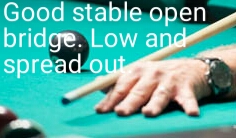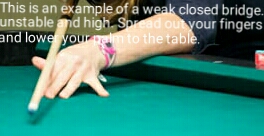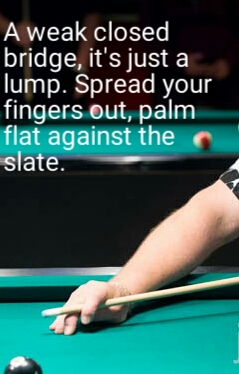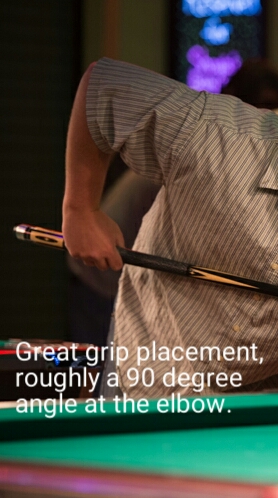The Basics of Cue Ball English
A billiard tutorial on the basics of cue ball english, by Jonathan Loder.
The Basics of Cue Ball English
Basics for cue ball english
To begin, it is a personal opinion that the application of english is not a law but a theory. If it were a law, it would work equally well for everyone that applied it. This is not the case due to a multitude of factors that have an affect on the outcome of the intensity of the english applied. It will vary from person to person, what one may use one tip of english for, another may use one and a half. You will have to practice, and before long, what you need to use will become instinctual.
For starters, I will be attacking the basic fundamentals of bridge, stroke and grip. These are important for proper english to be imparted on the cue ball consistently, and need to be used for proper actions. I will post further information on english accordingly. I believe these basics are important to nail down before progressing into direct application of english
The bridge, stroke and grip are large culprits of causing a plateau in the skill-level of progressing pool players. An unstable bridge will increase error exponentially with increasing power. A faulty stroke can cause errors of all sorts to include unwanted english application or lack of intended english. Last, but not least, grip. An improper grip can make or break your intended english application.
A common issue with these fundamentals is that bad habits are developed in a bar atmosphere. If you have just picked up a cue, they are easily corrected. If you have been a bar shooter or struggling league player for a time, it will take time and work, with uncomfortable adjustments to correct. I started as the second and have made the uphill climb (in some aspects still climbing) and will attest to the obvious progression in skill.
Bridge
So, first off, the bridge. If it is unstable, your contact point on the cue ball will move without you being able to perceive it. To correct this, you can use a variety of bridges.
First is the open bridge. See photos for descriptions of a closed bridge. This bridge is common amongst beginners, and is used by a few pros as well. It is reliable but does carry with it a small problem. When used for a power shot, such as a break, the cue can unseat itself from the bridge and cause errors. The open bridge is definitely useful for shots that the cue ball is close to or against the rail and is a good tool to have access to.



The second bridge is a closed bridge, this is the clichéd bridge that involves your index finger wrapping around the cue. See photos for descriptions of a closed bridge . This bridge helps keeps the cue on point for power shots, but does interrupt the line of sight down the cue shaft.




Stroke
Next on the agenda is stroke. The most common issues with stroke are failure to follow through the stroke, elevated cue and grip. Through personal experience, I have seen the negative effects of all three.
First up is the stroke, a good stroke will be smooth and accelerate through the cue ball. Too often people think that it doesn't matter that you decelerate. "So what if you are not still putting force into the stick after contact with the cue ball", the problem with this opinion is that if you are not following through, you will have already started to decelerate before contact with the cue ball. Make sure you are not starting your stroke like a rocket, forcing power will cause you to sacrifice control. This does not mean you can't have a power stroke though. Just make sure your acceleration is not a jerking motion, this is especially important if you use an open bridge. A side note to follow through is circumstance, you will have to take a different approach if the object ball is close to the cue ball. A good stroke with follow through will make your english work for you and become a key component in cue ball placement.
Next we have the elevated cue. An elevated cue is perceived to help increase draw or bottom english. This is not the case, although an elevated cue may be necessary in some situations such as bridging over a problem ball, it is more of a detriment to your shot an an enhancement. Elevating your cue will cause left or right english, however little, take an effect on the cue ball in motion and result in a higher amount of errors. Keep your cue stick as level with the table as possible. See photos for descriptions and examples. Correcting this may require someone watching you shoot as it is hard to tell if you are elevating by feel.


Grip on the Pool Cue
Lastly, grip. There are two aspects that I want to touch on. Grip placement and grip intensity.
To determine a proper grip placement, you need to approach a ball as if you were going to shoot. Place the cue tip as close to touching the ball as possible. Once you have the tip in place, make sure your shooting arm is close to a 90 degree angle at the elbow. See pictures for descriptions and examples. This will indicate where, on the cue, you should be gripping consistently.

Okay, grip intensity, I learned this late and had to really work to get it under wraps. After getting it down, my power draw shot went from 10-12 inches to being able to draw full table and then some. It is a simple idea but is hard to keep proper during the stroke. You don't need to have a death grip on the cue stick. Just let the cue rest in your hand and grip it gently, don't worry, it's not going to fly backwards out of your hand. The hard part with this is keeping from going back to a firm grip when you start your stroke. With focused practice it will become second nature to you.
These have been what I've noticed to be fundamentally wrong with most players who pick up their skills in a bar and just develop ways that work for them. Don't get me wrong, multiple shooters have excelled with methods different than these, but they are fewer the closer you get to the top of the charts.
I am always willing to discuss anything I have covered and more, please do not hesitate to ask for clarification or call me out on something I'm wrong about.
The Basics of Cue Ball English
- Title: The Basics of Cue Ball English
- Author: Loder
- Published: 10/31/2016 2:42:19 PM
- Last Updated: 10/31/2016 3:08:57 PM
- Last Updated By: billiardsforum (Billiards Forum)
The Basics of Cue Ball English
The The Basics of Cue Ball English article belongs to the Billiard Fundamentals and Basics category. Pool playing tips for the beginner. Get started with these fundamental billiard drills
The Basics of Cue Ball English Comments
There are not yet any comments. Please post one below. All comments are moderated.
Reply and share your comments below:
